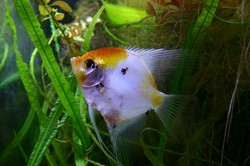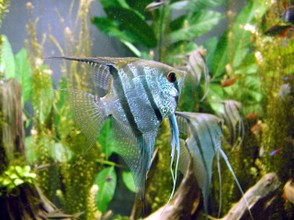If you are looking for some interesting angelfish facts to help you decide if you should buy one for your aquarium, then you have come to the right place. With over a 100 different species to choose from, you can either choose freshwater angelfish of the South American rivers or saltwater angelfish of the salty ocean waters. So, let's have a look at some interesting angelfish facts in this article.

Interesting Facts about Angelfish
by Roohi
Do you want to learn some interesting angelfish facts? Get to know about the characteristics of both the freshwater as well as the saltwater angelfish.
Shapes, size, and colors of freshwater and saltwater angelfish
Angelfish belong to the Cichlidae family. They look like a disc on edge and have long fins at the top and the bottom. Their scientific name is Pterophyllum scalare, where Pterophyllum refers to a 'winged leaf' and scalare refers to 'a flight of stairs'. This is quite descriptive of the fish that looks like a leaf with its dorsal fins looking like a ladder.
Freshwater angelfish is more triangular in shape compared to the marine variety. It usually grows only up to only around 6 inches in length. On the other hand, the saltwater angelfish can grow up to as long as 16 inches.
These fishes are in abundant supply which keeps them quite reasonably priced and their selective breeding has ensured that they are available in a variety of different colors. They come in an array of colors and you can choose the orange and purple Coral Beauty or the beautifully bright yellow Lemon Peel and these are only just a few colors that you can find in angelfish.
In short, if you are looking for an inexpensive and gorgeous pet, try out this beautiful fish.
Angelfish housing
Angelfishes are very territorial and picky about their living space. Also, since they can grow up to a size of 16 inches, depending on the variety, the tank size should be at least 15 gallons.
This can go up to 75 gallons depending on the length that the variety chosen can grow up to. This will ensure that the fully grown pair and their herd have enough space to move around and the parents do not eat their eggs or their young.
Water Quality and Ideal Diet for Your Angelfish
Since most of the angelfish varieties come from the rivers, the ideal water quality is soft and slightly acidic with a pH balance of 6.5 to 6.9. There should also be good circulation, good oxygen levels, low levels of nitrate, and comfortable temperatures for the fish to thrive.
If you are concerned about how to provide the coral for your saltwater angelfish, here is an interesting fact that will put your mind at ease. This aquarium fish can survive on just flake food alone.
However, you should provide live food once in a while by feeding it with brine shrimp, black worms, or small clams. You can even try dried foods that are easily available in any pet supply store. If you take good care of these fish, they can easily survive for 10 years, with some even living for around 15 years.
Breeding Your Angelfish
You can identify that spawning is about to occur when the ovipositors appear in the females for releasing the eggs and thin and pointed tube appears for their fertilization in the males. This is the only way to differentiate male fish from the female ones.
The spawning site is selected and cleaned. After a few test runs by both the female and the male, the spawning will begin. The female passes over the site and deposits the eggs followed by the male which moves in and fertilizes them. This continues happening till the time around 1000 eggs have been laid.
The parents then continue to fan the spawn for better circulation of the water around the hatchery. As soon as the eggs turn white, they are removed by the parents. It is best to provide the parents as much peace and quiet while the eggs are hatching.
Get more information here
 | Angelfish: Understanding and Keeping Angelfish (Fish Keeping Made Easy) The beautiful and graceful angelfish is without doubt the most popular acquisition for any home freshwater aquarium. Available in various configurations, colors, and price range... |
 | Breeding & Raising Angelfishes Freshwater angelfishes are easily considered the most popular freshwater aquarium fishes and have been a staple in tropical fish hatcheries for decades. Whether you are interest... |
 | Angelfish (Barron's Complete Pet Owner's Manuals) These tropical reef-dwellers make beautiful additions to any tank, but many are aggressive to other species. Here is detailed advice on keeping active, healthy Angelfish. Barron... |
Time to Buy an Angelfish!
After reading these interesting angelfish facts you must have decided to add this aquarium fish to your home. You should keep in mind is that these are aggressive eaters, so make sure that the less aggressive fish in your aquarium get their due share during feeding time. Also, carefully choose the other fish variety that you would like to keep in your tank with your angelfish.
You might also like
Interesting Facts about the European Shorthair CatAre you thinking of buying a house cat? Why not get a European shorthair cat ...
Interesting Facts about Sable FerretsA sable ferret can be a lively addition to your family. Get some fun facts ab...








 Tips to reduce computer eye strainon 03/23/2013
Tips to reduce computer eye strainon 03/23/2013
 Why Can't I Sleep at Night?on 03/14/2013
Why Can't I Sleep at Night?on 03/14/2013
 What is a Birthstone and what is my Birthstone?on 12/03/2012
What is a Birthstone and what is my Birthstone?on 12/03/2012
 Beautiful Flower Jewelryon 12/02/2012
Beautiful Flower Jewelryon 12/02/2012



Comments
Angelfish are my favorite freshwater fish! I've been having mine for a few years now. I have two in a 46 gallon bow front aquarium. They seemed to be at home right away as they did not hide at all. They swim together for the most part but seem to have no issues swimming on their own either. They are fun to watch as they slowly swim through the tank.
Great tips for me to choosing the angelfish for my fish tank. Learned from this a lot!
Great article. Nice to see some fish who don't have to be removed from their eggs for a change.
Interesting article, learned a lot!
Thanks, Mira!
Hi Roohi, I enjoyed your article :-)